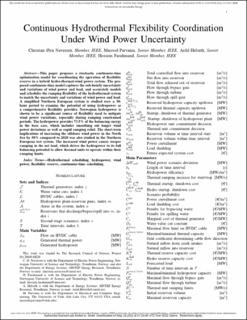| dc.contributor.author | Naversen, Christian Øyn | |
| dc.contributor.author | Parvania, Masood | |
| dc.contributor.author | Helseth, Arild | |
| dc.contributor.author | Farahmand, Hossein | |
| dc.date.accessioned | 2022-07-21T07:01:25Z | |
| dc.date.available | 2022-07-21T07:01:25Z | |
| dc.date.created | 2022-05-19T09:27:42Z | |
| dc.date.issued | 2022 | |
| dc.identifier.issn | 1949-3029 | |
| dc.identifier.uri | https://hdl.handle.net/11250/3007434 | |
| dc.description.abstract | This paper develops a stochastic continuous-time optimization model for coordinating the operation of flexibility in a hybrid hydro-thermal-wind power system. The developed model gives insight for investigating the short-term interactions between the different generation technologies. The continuous-time model captures the sub-hourly variations of wind power and load, and can accurately model the ramping capability of the system. A simplified Northern European system is studied over a 30 hour period to examine the potential of using hydropower as a comprehensive flexibility provider. Norwegian hydropower is shown to be a significant source of flexibility used to mitigate wind power variations, especially during ramping constrained periods. The hydropower provides 73.5% of the balancing energy in the base case, which includes smoothing out longer wind power deviations as well as rapid ramping relief. The short-term implications of increasing the offshore wind power in the North Sea by 50% compared to 2020 was also studied in the Northern European test system. The increased wind power causes steeper ramping in the net load, which drives the hydropower to its full balancing potential to allow thermal units to operate within their ramping limits. | en_US |
| dc.description.abstract | Continuous Hydrothermal Flexibility Coordination Under Wind Power Uncertainty | en_US |
| dc.language.iso | eng | en_US |
| dc.publisher | IEEE | en_US |
| dc.title | Continuous Hydrothermal Flexibility Coordination Under Wind Power Uncertainty | en_US |
| dc.title.alternative | Continuous Hydrothermal Flexibility Coordination Under Wind Power Uncertainty | en_US |
| dc.type | Peer reviewed | en_US |
| dc.type | Journal article | en_US |
| dc.description.version | acceptedVersion | en_US |
| dc.rights.holder | © 2022 IEEE. Personal use of this material is permitted. Permission from IEEE must be obtained for all other uses, in any current or future media, including reprinting/republishing this material for advertising or promotional purposes, creating new collective works, for resale or redistribution to servers or lists, or reuse of any copyrighted component of this work in other works. | en_US |
| dc.source.journal | IEEE Transactions on Sustainable Energy | en_US |
| dc.identifier.doi | 10.1109/TSTE.2022.3175430 | |
| dc.identifier.cristin | 2025446 | |
| dc.relation.project | Norges forskningsråd: 268014 | en_US |
| cristin.ispublished | true | |
| cristin.fulltext | postprint | |
| cristin.qualitycode | 1 | |
